University of Technology Sydney
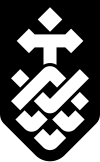 | |
Former name | New South Wales Institute of Technology (1964–1988) |
|---|---|
| Motto | "Think. Change. Do." |
| Type | Public research university |
| Established | 1988 |
| Endowment | A$147 million (2018)[1] |
| Budget | A$1.1 billion (2019)[1] |
| Chancellor | Catherine Livingstone |
| Vice-Chancellor | Attila Brungs |
Academic staff | 2,183 (2020)[2] |
Administrative staff | 2,222 (2020)[2] |
| Students | 46,328 (2020)[2] |
| Undergraduates | 33,816 (2020)[2] |
| Postgraduates | 10,223 (2020)[2] |
| 2,289 (2020)[2] | |
| Location | , , Australia Coordinates: 33°53′01″S 151°12′03″E / 33.883611°S 151.200833°E |
| Campus | Urban |
| Colors | Black, White, Blue & Red |
| Affiliations | |
| Website | uts |
 | |
The University of Technology Sydney (UTS) is a public research university located in Sydney, Australia. Although its origins are said to trace back to the 1870s, the university was founded in its current form in 1988. As of 2020, UTS enrols 46,328 students through its 9 faculties and schools.[3]
The university is regarded as one of the world's leading young universities (under 50 years old), ranked 1st in Australia and 11th in the world by the 2021 QS World University Rankings.[4]
UTS is a member of the Australian Technology Network, the Association of Southeast Asian Institutions of Higher Learning and the Association of Commonwealth Universities.
History[]
The University of Technology Sydney originates from the Sydney Mechanics' School of Arts (the oldest continuously running Mechanics' Institute in Australia), which was established in 1833.[5] In the 1870s, the School formed the Workingman's College, which was later taken over by the NSW government to form, in 1882, the Sydney Technical College.[6]
In 1940 the NSW Parliament passed an Act to establish an Institute of Technology, which in 1964 led to the establishment of the New South Wales Institute of Technology (NSWIT). In 1968, the NSW Institute of Technology amalgamated with the NSW Institute of Business Studies. In 1976 NSWIT established the first law school in NSW outside the university sector. The Haymarket campus officially opened in 1985.
On 8 October 1987 university status was granted to NSWIT, which was followed by the passing of the University of Technology, Sydney, Act 1987. It was reconstituted as the University of Technology Sydney (UTS) in 1988, along with the incorporation of the School of Design of the former Sydney College of the Arts. In 1989, the University of Technology, Sydney, Act 1989 (NSW) formed UTS by absorbing the Kuring-gai College of Advanced Education (KCAE) and the Institute of Technical and Adult Teacher Education (ITATE) of the Sydney College of Advanced Education. An academic Structure of nine faculties and 25 schools was established in 1991.
The School of Design was initially housed at a campus in Balmain, which closed at the end of 1994, with the school moved to a new building at the city campus.[7][8] The environmental, biological and biomedical science schools were located on a campus at St Leonards, which was closed in 2006, which also relocated to the city campus following a redevelopment.[9][10]
The Kuring-Gai campus closed at the end of 2015, with classes and facilities moved into the main Haymarket campus. This marked the consolidation of UTS into a single unified campus in the Sydney CBD.[11]
Campus[]
This section relies too much on references to primary sources. (April 2020) |

The UTS city campus is located at the southern border of Sydney's central business district, close to Central station and Railway Square. The UTS Tower is the nucleus of the city campus, fronting on to Broadway.
The campus consists of five distinct precincts. Broadway, Haymarket and Blackfriars are located at the city campus, while precincts at Moore Park and Botany integrate specialist facilities with surrounding industry organisations.[12]
Broadway (located in Ultimo) is home to the faculties of Science, Health, Law, Arts and Social Sciences, Engineering and IT, and Design, Architecture and Building, as well as the UTS Library. Haymarket is the location of the Business School, UTS Startups, the UTS Animal Logic Academy and two lecture theatres in the Powerhouse Museum. The Blackfriars precinct in Chippendale contains the Blackfriars Children's Centre and research and innovation teams while the Moore Park precinct features sports facilities within the Rugby Australia Building and the Botany precinct consists of the specialist research facility UTS Tech Lab.[12]
The campus has been substantially transformed since 2008 by the university's City Campus Master Plan, a $1 billion-plus investment in new buildings and facilities, major upgrades and refurbishments.[13][14]
Buildings and architecture[]


The UTS Tower on Broadway (Building 1) is an example of brutalist architecture with square and block concrete designs. Completed and officially opened in 1979 by Premier Neville Wran, the Tower initially housed the NSW Institute of Technology, which transformed to become UTS in the late 1980s. In October 2006, the UTS Tower was voted the ugliest building in Sydney in a poll hosted by The Sydney Morning Herald, receiving 22% of the total vote.[15] The Tower is the largest campus building in terms of both height and floor space.[16]
Other notable buildings in the Broadway precinct include:
- Building 2, UTS Central, is intended as a central hub for the campus. Opened in August 2019, the 17-storey building is encased in glass and includes the UTS Library, the Faculty of Law, the Hive Super Lab, three large collaborative classrooms, student spaces and a food court. The new food court includes outlets such as Mad Mex, Chatime, PapaRich and Uni Bros, and all single-use plastic packaging has been replaced with fully compostable, reusable or recyclable alternatives.[17] It was designed by Australian architectural firm Francis-Jones Morehan Thorp.[18]
- Building 3, the Bon Marche Building, which dates to the 1890s and was named after the Parisian department store Le Bon Marché. Originally a department store operated by Marcus Clark & Co, the building now accommodates specialist facilities for the Faculty of Arts and Social Sciences.[19]
- Building 7, or the Vicki Sara Building, home to Faculty of Science administration and specialist facilities, and the Graduate School of Health. Designed by architects Durbach Block Jaggers, in association with BVN Architecture, it has been awarded a 6 Star Green Star Design and As-Built rating, certified by the Green Building Council of Australia, and includes many sustainable features including a rooftop garden with stormwater collection and recycled building materials.[20]
- Building 10 on Jones St colloquially known as 'the Fairfax Building' as it originally accommodated the printing facilities for the Fairfax-owned Sydney Morning Herald. It was later home to the Sydney Organising Committee for the Olympic Games (SOCOG), before being incorporated within the UTS campus in the early 2000s. It accommodates the Faculty of Arts and Social Sciences and the Faculty of Health.[21] The refurbished building received the 2003 Sir John Sulman Award for Public Architecture.
- Building 11, which opened in 2014 and accommodates the Faculty of Engineering and IT, along with many of its specialist facilities. Designed by architects Denton Corker Marshall, the building is encased in aluminium screens perforated with binary code. 'Gills' creased into the aluminium plates light up at night and symbolically represent the building as a living, breathing structure.[22]
- Alumni Green, the central green space on campus, encircled by prominent campus buildings including the Tower. Designed by landscape architects ASPECT Studio, Alumni Green consists of three distinct zones: a garden area with outdoor seating; a paved open space modelled on celebrated town squares; and a 1200m2 raised grass platform, which creates a green roof for a 13,000m2 underground Library Retrieval System.[23]
The Haymarket precinct includes buildings such as:
- Building 5, former market buildings with a heritage façade and modern interior.
- Building 8, the Dr Chau Chak Wing Building, is the first Australian building designed by celebrated architect Frank Gehry and is considered a contemporary architectural icon. The building accommodates teaching, learning, research and office space for the UTS Business School. Design features include a prominent polished stainless steel staircase that acts as a sculptural focal point in the main lobby, undulating brickwork with approximately 320,000 individual bricks referencing Sydney sandstone laid by hand and two oval classrooms constructed of large laminated timber beams.[24]
Additionally in the Moore Park precinct, the Rugby Australia Building contains specialist facilities for UTS students, staff and researchers working across sport and exercise science, physiotherapy and sport media. Designed by architects Populous, the building is also the headquarters of Rugby Australia and home to Australia's national rugby teams. The external fixed aluminium shading controls solar penetration, while internal spaces include the purpose-built laboratories of the Human Performance Research Centre.[25]
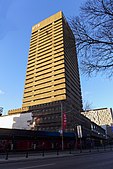
UTS Tower
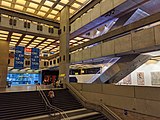
Internal atrium of UTS Tower

Dr Chau Chak Wing Building designed by Canadian architect Frank Gehry

The helix staircase in UTS Library
Building 10 was home to the Sydney Organising Committee for the Olympic Games
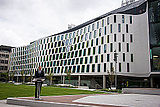
UTS Vicki Sara Building as viewed from Alumni Green
UTS Library[]
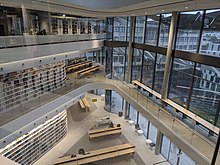
UTS provides services through the UTS Library and the UTS Reading Room in Building 2, UTS Central, as well as a range of online services on the UTS Library website.
Sustainability[]
A number of UTS campus buildings have received a certified Green Star rating from the Green Building Council of Australia. The Vicki Sara Building has been awarded a 6 Star Green Star Design and As-Built Rating,[26] while the Faculty of Engineering and IT and Dr Chau Chak Wing Buildings has been awarded 5 stars.[27][28] The newly constructed UTS Central is also targeting a 5 Star rating.[18]
Neighbouring organisations[]
The core of the UTS city campus is located close to many Sydney landmarks and notable organisations including the Australian Broadcasting Corporation, the Powerhouse Museum, TAFE Ultimo, the International Convention Centre Sydney, Darling Harbour and Chinatown.
Entities within the Central Park development, opposite the UTS Tower on Broadway, partner with the University on sustainability initiatives, which include a recycled water partnership and a district energy-sharing project commended at the 2018 Smart City Awards.[29][30]
Organisation and administration[]
Faculties and schools[]
The university consists of nine faculties and schools:[31]
- Faculty of Arts and Social Sciences
- School of Business
- Faculty of Design, Architecture and Building
- Faculty of Engineering and Information Technology
- Graduate School of Health
- Faculty of Health
- Faculty of Law
- Faculty of Science
- Faculty of Transdisciplinary Innovation
Other entities[]
In addition to the faculties, there are a number other units falling under the Provost and Senior Vice-President's division, within the remit of the Vice-Chancellor and President. As of 2021, these comprise three administrative units (Planning and Quality Unit, UTS Internal Audit and Chief Data Officer), as well as the:[32]
- Centre for Social Justice and Inclusion;[33] and
- Jumbunna Institute for Indigenous Education and Research[34] (formerly Jumbunna Indigenous House of Learning[35]).
The Graduate Research School, Institute for Public Policy and Governance, and the Institute for Sustainable Futures fall under the Deputy Vice-Chancellor and Vice-President (Research), a number of units relating to international students are governed by the Deputy Vice-Chancellor and Vice-President (International), and many other administrative units exist under similar divisions under the Vice-Chancellor and President.[32]
Governance[]
The UTS Academic Board is the principal advisory body to the UTS Council on academic matters.
The Academic Board is concerned with policy development as it relates to the University's academic programs in education, scholarship and research, and community service. It refers to policy recommendations to Council and discusses matters referred to it by Council.
Academic Board plays a key role in the UTS community in providing a forum for the discussion and debate of the academic directions of the University as well as the quality of its academic programs. The Board consists of academic staff members as well as student members elected for a general period of 1–2 years.[36]
- List of Chancellors
- RN Johnson (1989—1999)
- Sir Gerard Brennan (1999—2005)
- Vicki Sara (2005—2016)[37]
- Catherine Livingstone (2016—present)
- List of Vice-Chancellors
- RD Guthrie (1988—1996)
- AJD Blake (1996—2002)
- RE Milbourne (2002—2014)
- Attila Brungs (2014—2021)
Academics[]
Admissions[]
| 2018[38] | |
|---|---|
| Preferences | 39,875 |
| Offers | 7,577 |
| Offer rate | 19% |
| Enrolled | 6,191 |
Admissions is highly competitive with an offer rate of 19%. As of 2019, UTS had the third highest demand for places in NSW for university applicants.[38] For domestic applications, an Australian Tertiary Admission Rank (ATAR) of at least 69 is required. Applicants may also be eligible for admission if they have completed a UTS foundation course or an AQF Diploma. Applicants applying with an IB Diploma will have their scores converted into a UAC Rank for admission.[39]
In 2019, statistics by the Universities Admissions Centre (UAC) revealed that the Bachelor of Business program at UTS was the second most in-demand course in the state with 1,211 applicants placing it as their first preference. The Bachelor of Nursing program was the ninth most in-demand course with 647 applicants.[40]
Rankings[]
| University rankings | |
|---|---|
| University of Technology Sydney | |
| QS World[41] | 133 |
| THE World[42] | 160 |
| ARWU World[43] | 201–300 |
| US News World[44] | 162 |
| Australian rankings | |
| QS National[41] | 9 |
| THE National[45] | 9 |
| ARWU National[46] | 9–15 |
| US News National[47] | 9 |
| ERA National[49] | 14[48] |
The 2021 QS World University Rankings ranked UTS 9th in Australia and 133rd in the world.[4] UTS is ranked 9th in Australia and 160th internationally by the 2021 Times Higher Education World University Rankings. UTS is ranked 122nd (second in Australia) in the 2017 CWTS Leiden ranking.[50] The university is ranked in the 201st–300th bracket in the 2019 Academic Ranking of World Universities.[51]
UTS ranked 1st in Australia and 15th globally in the 2017 Times Higher Education top 150 universities 150 Under 50 Rankings.[52] Similarly, in the 2018 QS Top 50 Under 50 index of universities founded less than 50 years ago, UTS ranked 8th in the world and 1st in Australia.[53]
The Times Higher Education Rankings in 2020 ranked UTS; 60th in Law, 77th in Education and 79th in Computer Science in the world. In Australia, UTS is ranked 7th in the subject areas of Law, 3rd in Computer Science and 7th in Education[54]
In 2019, QS ranked UTS globally; 10th in Nursing, 23rd in Arts and Design and 24th in Sport and Exercise. UTS is ranked in the top 100 for Accounting and Finance, Architecture, Civil Engineering, Communication & Media Studies, Computer Science, Electrical Engineering and Law.[55]
The 2019 QS Graduate Employability Rankings ranked UTS graduates 6th most employable in Australia, and 64th in the world.[56]
Research[]
UTS is home to over 50 research centres and institutes. UTS mainly focuses its research in the areas of health, data science, sustainability, future work and industry and social futures.[57]
Some of the major research centres include; the Centre for Artificial Intelligence, Centre for Autonomous System, Centre for Health Technology, Advanced Analytics Institute, Centre for Forensic Science, Centre for Quantum Software and Information Technology, the i3 Institute (Infection, Immunity and Innovation), Climate Change Cluster (C3) and the Institute for Sustainable Future.
Student body[]
| 2018 | 2017 | 2016 | |
|---|---|---|---|
| Female | 49% | 49% | 49% |
| Under 25 | 69% | 68% | 66% |
| Language other than English | 49% | 48% | 46% |
| Born outside Australia | 50% | 49% | 48% |
| Indigenous | 1% | 1% | 1% |
In 2018, the university had an enrollment of 45,930 students. 33,070 are undergraduate students, 10,720 postgraduate students and 2,140 doctoral students. Of all students, 30,796 (67.1%) are Australian citizens or permanent residents and 15,134 (32.9%) are international students.[2]
Students were enrolled in 9 schools or faculties: The largest being the School of Business at 23.7 percent followed by the Faculty of Engineering and Information Technology at 23 percent. Other faculties and schools by enrolment include; 11.3 percent in the Faculty of Arts and Social Sciences; 10.9 percent in the Faculty of Design, Architecture & Building (DAB); 9.6 percent in the Faculty of science and 6.2 percent in the School of Law. Smaller number of students are enrolled in the Graduate School of Health and Faculty of Transdisciplinary Innovation.[2]
Student life[]
This section's tone or style may not reflect the encyclopedic tone used on Wikipedia. (September 2017) |
This section needs additional citations for verification. (September 2017) |
Activate UTS (formerly UTS Union) is the peak service provider at the University of Technology Sydney. It operates a range of on-campus student services, including food and beverage outlets, cultural activities, fitness and catering services as well as clubs and societies, student publications and Orientation Day. The City Campus is home to two licensed bars, 'The Underground' and 'The Loft'.
Activate UTS is governed by a board of thirteen directors consisting of seven students (elected by the student cohort in annual elections), two staff members (elected by the staff of the university), the CEO of Activate UTS, the chair (appointed by the university council), the treasurer (appointed by the university council) and one other director (appointed by the university council, usually external to the university or a former student).
From the seven students elected, a president and a vice-president is elected each year by the board. The chair is responsible for the conduct of the board meetings.
Residential life[]
UTS Housing is also a great part of a student community within UTS with its on-campus accommodation. They have four residences within a 15-minute walk from the campus and is home to more than 1,200 UTS students. Weekly events and excursions are also organised within the housing members ranging from social, academic and sports events.
Student media[]
UTS has its own community radio station on campus, 2SER FM. The studio is located on in building 18, known as the terraces, and broadcasts to the entire Sydney region. The station is jointly owned by UTS and Macquarie University, with a second studio at Macquarie University. UTS Journalism students help produce the station's news and current affairs programs including "The Wire" and "Razors Edge".
The UTS Students' Association is the representative student organisation at UTS. It publishes the student newspaper, Vertigo, runs the second hand bookshop and advocates on behalf of students both individually and collectively.
Sport[]
UTS sports clubs include:
- The Sydney Cricket Club was formed in 2007 from a merger between the Sydney Cricket Ground Trust and the UTS Balmain Cricket Club
- UTS Australian Football Club or "The Bats"
The general sporting colours at UTS are green and black.
Notable alumni[]
Notable alumni of the University of Technology Sydney include actor, Hugh Jackman; former Deputy Leader of the Opposition, Tanya Plibersek; former Premier of New South Wales, Morris Iemma; Vietnamese-born Australian actor and comedian, Anh Do; Australian actress and model, Charlotte Best; Australian television presenter and media personality, Sonia Kruger; former Deputy Lord Mayor of Sydney, Henry Tsang; former 2GB and CNN news anchor, Joel Labi; Australian cricketer, Pat Cummins; Australian television presenter and sports journalist, Lara Pitt and Deputy Senior Crown Prosecutor of New South Wales, Margaret Cunneen, and Henry.
See also[]
- Kenvale College of Tourism & Hospitality Management, an institution with an articulation agreement with the University of Technology Sydney
- List of universities in Australia
- UTS Glenda Adams Award for New Writing, a literary award sponsored by UTS
References[]
- ^ Jump up to: a b "UTS Annual Report 2018" (PDF). University of Technology Sydney. 2018.
- ^ Jump up to: a b c d e f g h i "UTS facts, figures and rankings numbers". UTS official website. Archived from the original on 24 October 2014.
- ^ "Facts, figures and rankings". University of Technology Sydney. Retrieved 23 October 2020.
- ^ Jump up to: a b "QS Top 50 Under 50 2021". Top Universities. 24 June 2020. Retrieved 5 July 2020.
- ^ Dictionary of Sydney staff writer (2008). "Sydney Mechanics' School of Arts". Dictionary of Sydney. Dictionary of Sydney Trust. Archived from the original on 2 April 2015. Retrieved 27 January 2015.
- ^ Catherine Freyne (2010). "Sydney Technical College". Dictionary of Sydney. Dictionary of Sydney Trust. Archived from the original on 26 April 2015. Retrieved 27 January 2015.
- ^ "UTS School of Design Open Day". Sydney Morning Herald. 17 August 1993. Retrieved 11 January 2019.
- ^ "1994 Engineering Handbook" (PDF). University of Technology Sydney. Retrieved 11 January 2019.
- ^ "1998 Science Handbook" (PDF). University of Technology Sydney. Retrieved 11 January 2019.
- ^ "2006 UTS Calendar" (PDF). University of Technology Sydney. Retrieved 11 January 2019.
- ^ "UTS celebrates a new beginning for its Kuring-gai campus". UTS Newsroom. 3 September 2015. Retrieved 11 January 2019.
- ^ Jump up to: a b "Our precincts | University of Technology Sydney". www.uts.edu.au. Retrieved 10 April 2019.
- ^ "Our vision | University of Technology Sydney". www.uts.edu.au. Retrieved 10 April 2019.
- ^ "Aluminium binary code screen adorns new UTS building by Denton Corker Marshall". Architecture & Design. Retrieved 21 June 2020.
- ^ Cubby, Ben (1 November 2006). "Ugly talk strikes a chord in city's heart". Sydney Morning Herald. Fairfax Media. Archived from the original on 5 June 2009.[verification needed]
- ^ "Our campus | University of Technology Sydney". www.uts.edu.au. Retrieved 10 April 2019.
- ^ "Hello, new UTS Central food court". University of Technology Sydney. Retrieved 23 August 2021.
- ^ Jump up to: a b "UTS Central". University of Technology Sydney. Retrieved 11 April 2019.
- ^ "Our buildings | University of Technology Sydney". www.uts.edu.au. Retrieved 10 April 2019.
- ^ "Vicki Sara Building (Building 7) | University of Technology Sydney". www.uts.edu.au. Retrieved 10 April 2019.
- ^ "Façade fix the latest chapter in Building 10's long story | University of Technology Sydney". www.uts.edu.au. Retrieved 10 April 2019.
- ^ "Faculty of Engineering and IT Building (Building 11) | University of Technology Sydney". www.uts.edu.au. Retrieved 10 April 2019.
- ^ "Alumni Green | University of Technology Sydney". www.uts.edu.au. Retrieved 10 April 2019.
- ^ "Dr Chau Chak Wing Building | University of Technology Sydney". www.uts.edu.au. Retrieved 10 April 2019.
- ^ "Rugby Australia Building, Moore Park | University of Technology Sydney". www.uts.edu.au. Retrieved 10 April 2019.
- ^ "Vicki Sara Building sustainability fact sheet" (PDF). University of Technology Sydney. Retrieved 10 April 2019.
- ^ "Dr Chau Chak Wing Building sustainability fact sheet" (PDF). University of Technology Sydney. Retrieved 10 April 2019.
- ^ "Faculty of Engineering and IT Building sustainability fact sheet" (PDF). University of Technology Sydney. Retrieved 10 April 2019.
- ^ "UTS highly commended at Smart City Awards | University of Technology Sydney". www.uts.edu.au. Retrieved 10 April 2019.
- ^ says, Rubens Camejo (18 October 2018). "Central Park shares recycled water with UTS across the road". The Fifth Estate. Retrieved 10 April 2019.
- ^ "Facts, figures and rankings". University of Technology Sydney. Retrieved 22 February 2021.
- ^ Jump up to: a b "UTS organisational structure" (PDF). University of Technology Sydney. Retrieved 22 February 2021.
- ^ "Centre for Social Justice and Inclusion". University of Technology Sydney. Retrieved 22 February 2021.
- ^ "Jumbunna Institute for Indigenous Education and Research". University of Technology Sydney. Retrieved 22 February 2021.
- ^ "UTS Calendar 2014" (PDF). University of Technology Sydney. December 2013: 24. Cite journal requires
|journal=(help) - ^ "UTS: Academic Board – Governance Support Unit". uts.edu.au. Archived from the original on 19 February 2011.
- ^ Timeline Archived 11 November 2007 at the Wayback Machine
- ^ Jump up to: a b "University preference statistics for 2019 admissions compared to 2018" (PDF). Universities Admissions Centre. 2019.
- ^ "Admissions criteria". UTS. Retrieved 1 May 2020.
- ^ "Top 10 most in-demand courses". Universities Admissions Centre. 24 January 2019. Retrieved 29 September 2019.
- ^ Jump up to: a b "QS World University Rankings 2022". Quacquarelli Symonds Limited.
- ^ "World University Rankings 2021". Times Higher Education.
- ^ "Academic Ranking of World Universities 2021". Shanghai Ranking Consultancy.
- ^ "U.S. News and World Report Best Global Universities Rankings". U.S. News and World Report.
- ^ "THE 2021 - Australia". Times Higher Education.
- ^ "Academic Ranking of World Universities 2021". Shanghai Ranking Consultancy.
- ^ "U.S. News and World Report Best Global Universities in Australia". U.S. News and World Report.
- ^ "All unis winners in research audit". The Australian. 4 December 2015. Archived from the original on 31 December 2016. Retrieved 21 February 2017.
- ^ "Australian University Rankings". Australian Education Network.
- ^ "CWTS Leiden Ranking 2020". Centre for Science and Technology Studies, Leiden University.
- ^ "Academic Ranking of World Universities 2017". Shanghai Ranking Consultancy. Archived from the original on 15 August 2017.
- ^ "Young University Rankings". 4 April 2017. Archived from the original on 5 April 2017.
- ^ "QS University Rankings: Top 50 Under 50 2018". 10 July 2017. Archived from the original on 12 September 2017.
- ^ "Explore ranking data for University of Technology Sydney". Retrieved 28 September 2019.
- ^ "University of Technology Sydney". Retrieved 28 September 2019.
- ^ "Graduate Employability Rankings 2019". Top Universities. 7 September 2017. Retrieved 15 January 2019.
- ^ "Welcome to UTS research". University of Technology Sydney. Retrieved 28 September 2019.
External links[]
| Wikimedia Commons has media related to University of Technology, Sydney. |
- University of Technology Sydney
- Universities in Sydney
- Australian Technology Network
- 1988 establishments in Australia
- Educational institutions established in 1988
- Ultimo, New South Wales
- Buildings and structures awarded the Sir John Sulman Medal
- Railway Square, Sydney






